The multiple driver thing doesn't add up from his posts.
Not trying to argue with you, but look at his posts. He said you can build one for under $300, with the alpine driver costing under $200. With more than one driver that's already over $400 without any Baltic Birch to build the cabinet.
Not trying to argue with you, but look at his posts. He said you can build one for under $300, with the alpine driver costing under $200. With more than one driver that's already over $400 without any Baltic Birch to build the cabinet.
Hi m R g S r,
No problem from me either, I think I found what he is doing in Post #2: "...Alpine SWR-1522D...".
So he has a Hornresp Input for "four Alpine SWS-10D2", and then a Hornresp SPL for the "Alpine 15in. v. the MTX 15in.", and the Hornresp Input does not reflect the box from the drawing in Post #1.
It's all pretty clear now.
Regards,
No problem from me either, I think I found what he is doing in Post #2: "...Alpine SWR-1522D...".
So he has a Hornresp Input for "four Alpine SWS-10D2", and then a Hornresp SPL for the "Alpine 15in. v. the MTX 15in.", and the Hornresp Input does not reflect the box from the drawing in Post #1.
It's all pretty clear now.
Regards,
Last edited:
This one is pretty much as clear as most of Patrick's postsNo problem from me either, I think I found what he is doing in Post #2: "...Alpine SWR-1522D...".
So he has a Hornresp Input for "four Alpine SWS-10D2", and then a Hornresp SPL for the "Alpine 15in. v. the MTX 15in.", and the Hornresp Input does not reflect the box from the drawing in Post #1.
It's all pretty clear now.
The Alpine SWR-1522D does look like a good value.
Art and TB46 noted some mistakes in my first and second post, so I took some time to double check, and make corrections.
First off, TB46 is correct - the hornresp data in post #2 is for a quad of the Alpine SWS-10D2, not the Alpine SWR-1542D.

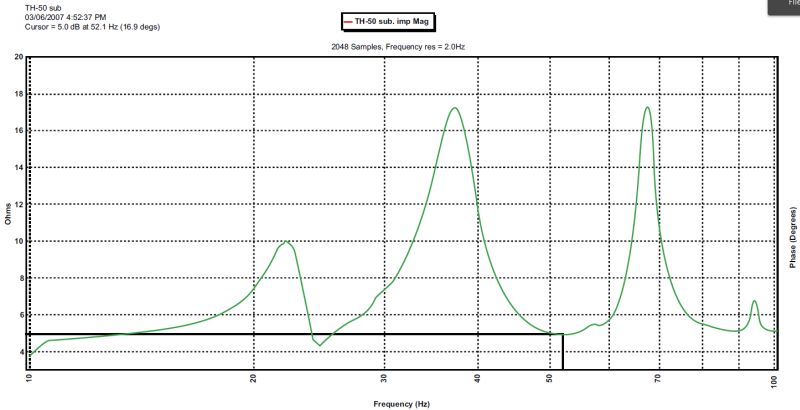
First off, here's the advertised frequency response and impedance of the Danley TH-50, which likely uses the now-discontinued MTX 9515 15" subwoofer. Note the location of the impedance dips and peaks; IMHO this helps 'guide us' to the correct folding and taper. In particular, the dips at 25 and 52hz, indicative of a resonance at those frequencies.
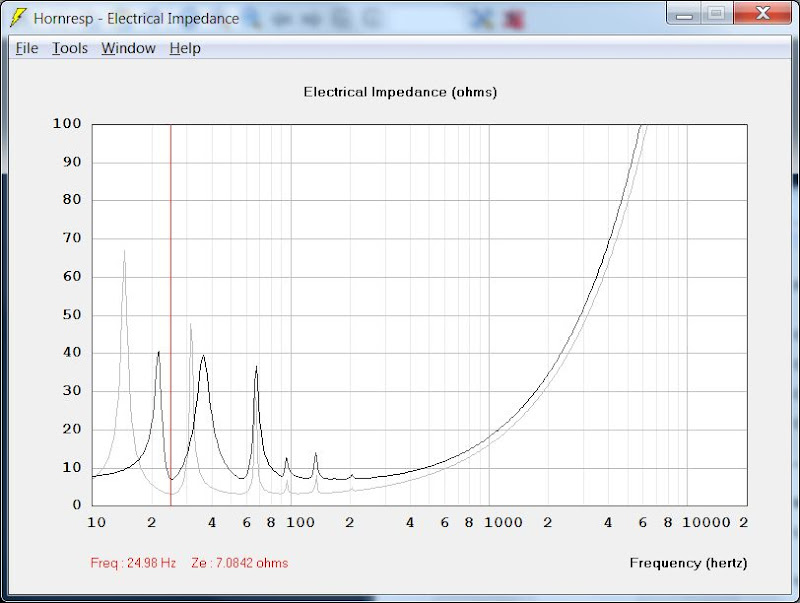
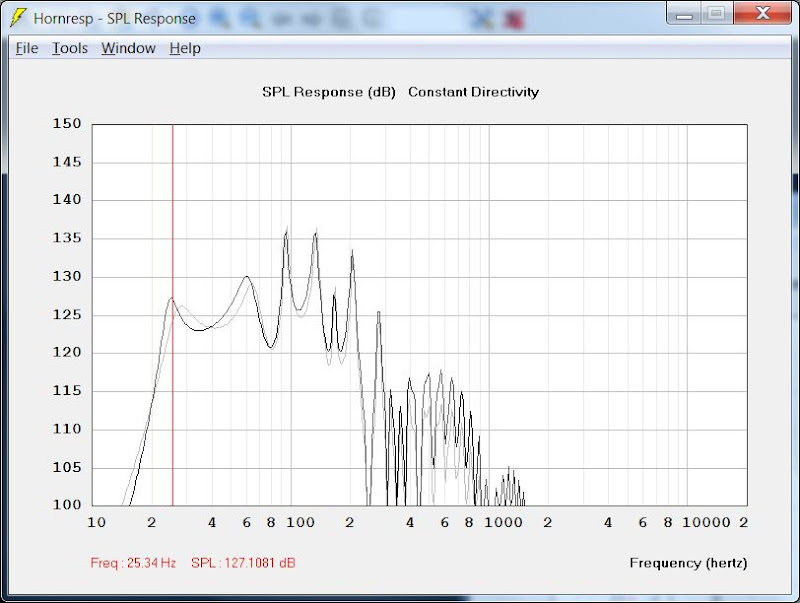
Here's the impedance response and frequency response of my 'guesstimate' of the TH-50, along with my variant on the same box, using the Alpine SWR-1522D.
Here's some notes on the two boxes:
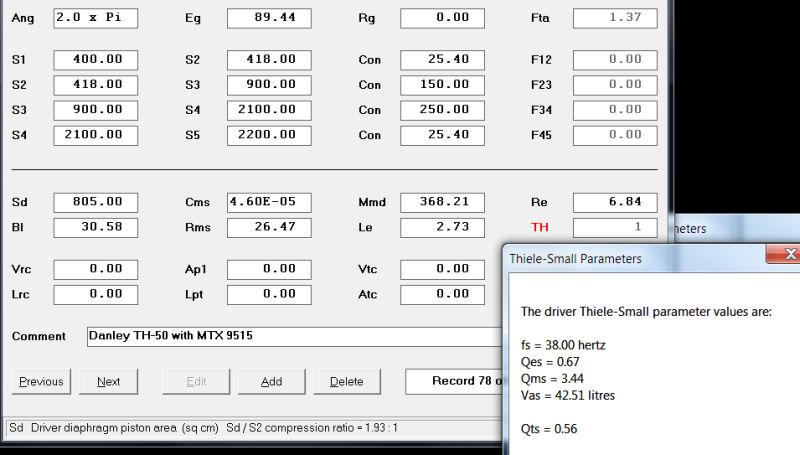
Here's the hornresp input screen for the TH-50 'guesstimate' with the MTX 9515
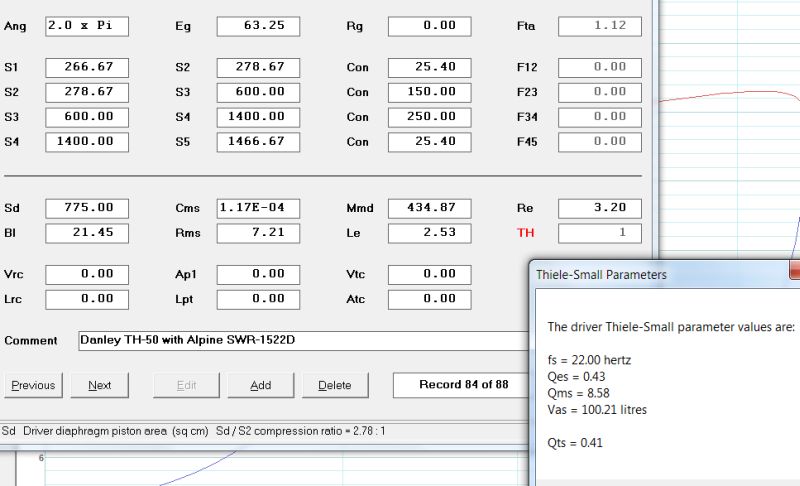
Here's the hornresp input screen for the Alpine SWR-1522D variant. Note that all volumes are 2/3rds as much, but all horn segments are of equal length.
This folding seems to work well with a ton of drivers; I was able to achieve even flatter response with four of the Alpine Type S 10" woofers. (That's the screen I accidentally posted on the first page, my mistake.) The Type S is a little flatter, but at a higher cost; for sheer output the $200 Alpine SWR-1522D is a monster.
The Danley TH-50 with the MTX 9515 has more output than my 'variant.' The nice thing about my 'variant' is that the driver is widely available, the box size is 1/3rd smaller, and three of my variants will equal the output of two th-50s, in the same footprint as two th-50s, at a lower cost.
Thanks to everyone for double checking my work!
First off, TB46 is correct - the hornresp data in post #2 is for a quad of the Alpine SWS-10D2, not the Alpine SWR-1542D.


First off, here's the advertised frequency response and impedance of the Danley TH-50, which likely uses the now-discontinued MTX 9515 15" subwoofer. Note the location of the impedance dips and peaks; IMHO this helps 'guide us' to the correct folding and taper. In particular, the dips at 25 and 52hz, indicative of a resonance at those frequencies.


Here's the impedance response and frequency response of my 'guesstimate' of the TH-50, along with my variant on the same box, using the Alpine SWR-1522D.
Here's some notes on the two boxes:
- The folding of the two boxes is *exactly* the same. The Danley TH-50 is 25.5" deep; the Alpine variant I've posted here is 17" deep. (One third less volume.)
- On page one I made a mistake. I used the Thiel Small parameters from the MTX T815-44, instead of the MTX 9515. I've fixed that in these updated graphs.
- For the 9515, I used the Thiele-Small parameters from data-bass.com (Data-Bass). According to their measurements, the 9515 is nominally an 8ohm driver. So in the graphs I've used 1000 watts into 8ohms for the 9515, and 1000 watts into 4ohms for the SWR-1522D. (2 ohm voice coils wired in series.)
- Note that there's a strong correlation between the impedance peaks in the hornresp prediction for the 9515, and the published data. (See how they both have dips at 25hz and 52hz?) This is a good indicator that the horn geometry is a close match imho.

Here's the hornresp input screen for the TH-50 'guesstimate' with the MTX 9515

Here's the hornresp input screen for the Alpine SWR-1522D variant. Note that all volumes are 2/3rds as much, but all horn segments are of equal length.
This folding seems to work well with a ton of drivers; I was able to achieve even flatter response with four of the Alpine Type S 10" woofers. (That's the screen I accidentally posted on the first page, my mistake.) The Type S is a little flatter, but at a higher cost; for sheer output the $200 Alpine SWR-1522D is a monster.
The Danley TH-50 with the MTX 9515 has more output than my 'variant.' The nice thing about my 'variant' is that the driver is widely available, the box size is 1/3rd smaller, and three of my variants will equal the output of two th-50s, in the same footprint as two th-50s, at a lower cost.
Thanks to everyone for double checking my work!
Hi Patrick Bateman,
Post #27: "... even flatter response with four of the Alpine Type S 10" woofers..."
Well, here you go again. Just two questions:
Just two questions:
1. How do you propose to mount four 10" drivers in this box?
2. Have you at least taken a look at the sketch I posted in Post #21?
Your data in Hornresp (Post #2, the dashed black lines in my roll-out drawing, that is labled 'From PB Hornresp') does not agree with the size of your box (Post #1, the blue solid roll-out lines labled 'From drawing') (even if executed in 1/2" wood, as I did in the drawing, the actual horn path is not even close to the size of the Hornresp horn path. By the way, I would not recommend that light a wood for this box).
Please, let me know if I missed something, as I find this to be an interesting example of the TH.
Regards,
Post #27: "... even flatter response with four of the Alpine Type S 10" woofers..."
Well, here you go again.
1. How do you propose to mount four 10" drivers in this box?
2. Have you at least taken a look at the sketch I posted in Post #21?
Your data in Hornresp (Post #2, the dashed black lines in my roll-out drawing, that is labled 'From PB Hornresp') does not agree with the size of your box (Post #1, the blue solid roll-out lines labled 'From drawing') (even if executed in 1/2" wood, as I did in the drawing, the actual horn path is not even close to the size of the Hornresp horn path. By the way, I would not recommend that light a wood for this box).
Please, let me know if I missed something, as I find this to be an interesting example of the TH.
Regards,
Attachments
Hi Patrick Bateman,
Post #27: "... even flatter response with four of the Alpine Type S 10" woofers..."
Well, here you go again.Just two questions:
1. How do you propose to mount four 10" drivers in this box?
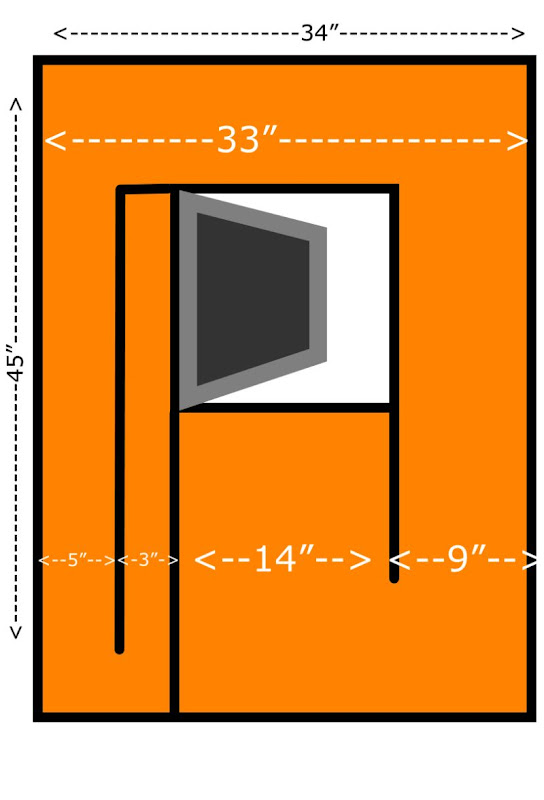
This is how you mount the MTX 9515 15" woofer, and the Alpine SWR-1522D 15" woofer. Note that the cabinet width for the Alpine is reduced by one third, as detailed in my post from earlier this week.
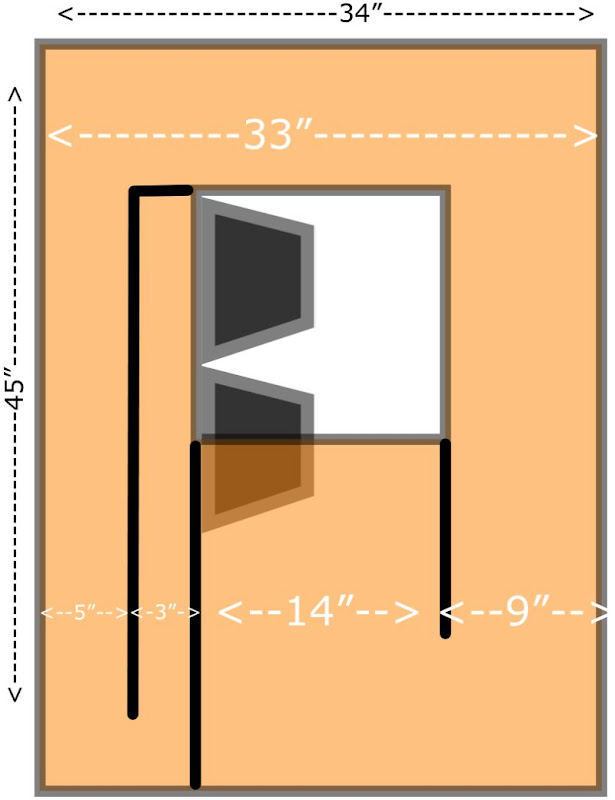
Instead of a single MTX 9515 15" woofer, one can use *four* of the Alpine SWS-10D2 woofers. These are widely available. For instance, they're readily available "over the counter" at Car Toys for under $100 each. You can likely find them at the usual suspects too. (Best Buy, your local Alpine dealer, etc.) The Type S woofers are way easier to find than the Type X or the Type R.
Anyways, if you want to use four tens instead of one fifteen, I would mount them as illustrated above. Note that the woofers are mounted "two deep." The dimensions of the cabinet are the exact same as the Danley TH-50, IE it's 25.5" deep.
One might wonder "why would I use four tens?" There *are* a few advantages to four tens over one fifteen:
1) The power handling of four tens is potentially very high, as the thermal load is distributed over *four* 2.6" voice coils instead of the single 2.6" voice coil in the Alpine 15".
2) To me, the most attractive advantage of using tens instead of fifteen is that you can split the cabinet in half. For instance, instead of using a single cabinet that's 25.5" deep you could use *two* cabinets with half of the depth each, and half of the woofers. In a home environment this allows one to implement a 'Geddes style' multi-woofer setup.
2. Have you at least taken a look at the sketch I posted in Post #21?
Your data in Hornresp (Post #2, the dashed black lines in my roll-out drawing, that is labled 'From PB Hornresp') does not agree with the size of your box (Post #1, the blue solid roll-out lines labled 'From drawing') (even if executed in 1/2" wood, as I did in the drawing, the actual horn path is not even close to the size of the Hornresp horn path. By the way, I would not recommend that light a wood for this box).
Please, let me know if I missed something, as I find this to be an interesting example of the TH.
Regards,
I have a big project due tomorrow morning but hope to have some time to double check the dimensions of my illustration versus the hornresp data.
Patrick, you mention both the Alpine SWR-1522D and Alpine SWR-1542D.
Are both these drive applicable to this design?
Not just the SWR-1522D and the 1542D, there are practically a hundred drivers that work in the TH-50.*
Here's my take on it:
Tapped horns are more sensitive to driver parameters than vented boxes and sealed boxes. BUT they're not *that* sensitive. And particularly when the horn is large, the driver parameters become less important.
^^^ all of that is my opinion of course.
Here's an example of what I mean:
The Danley TH-115 is a 14.84 cubic foot tapped horn. For a fifteen, that's relatively small. But the TH-50 is a whopping 22.6 cubic feet. And due to that 'bump' in size, the TH-50 horn geometry tends to 'dominate' the frequency response of the horn.
Basically, the bigger your tapped horn is, the less critical it is to have a driver that's a 'perfect' match for the horn. This can be particularly helpful if you're using car audio drivers, where the qts is much higher than what you'll see with prosound drivers.
An externally hosted image should be here but it was not working when we last tested it.
Here's an example of what I mean, from the very good data-bass.com site**. They built a Danley DTS-10 with both the 'stock' driver and also with a TC Sounds driver. See how the response is quite similar?
And I'm a big fan of car audio drivers. They're easier to find than prosound drivers, and they tend to offer massive amounts of displacement for the money. For instance, I challenge anyone to show me a B&C driver that delivers as much output per dollar as the Alpine Type S and Type R drivers. The flat BL curve of those drivers is just icing on the cake.
* off the top of my head, you can use the Alpine Type R fifteens, both the 4ohm and 2ohm. You can also use the tens, but you need to use multiple drivers, or reduce the depth of the horn to get the volume down. I'd be willing to bet that two of the twelves could be used instead of one of the fifteens. And on top of that, there are about a hundred car audio drivers with similar parameters. The thiele-small parameters of the Alpine drivers are pretty standard for car audio drivers, the main difference between the Alpines and the rest of the pack is the flat BL curve at such a low price point.
** full data on the dts-10 experiment : http://www.data-bass.com/data?page=content&id=1
Last edited:
Does anyone know if MTX has released a replacement for the discontinued 15? I looked around online and all the MTX 15s I can find now seem a little....lackluster.
Edit: The Alpine looks cool, but I think I'd really like to try the TH-50 as close to a clone as I could.
I have an excuse to build new THs as my old ones were water damaged, so I've been mental-shopping around to see what's out there, and this looks to be a decently easy thing to try.
Edit: The Alpine looks cool, but I think I'd really like to try the TH-50 as close to a clone as I could.
I have an excuse to build new THs as my old ones were water damaged, so I've been mental-shopping around to see what's out there, and this looks to be a decently easy thing to try.
The replacement isn't what the old driver was, which is why Danley stopped making this. (Or so I hear).
Tundra scooped up 4 drivers somehow, and he may have all 4 cabinets completed by now. Not sure. That must be prettyyy nutty!
It wasn't as easy as scooping them up haha, I paid my out of work brother to call every car audio dealer in the country that we could find. I have LF that would make anyone smile! I'm actually looking at buying a shipping container to store some of the designs I've made, the house is full of speakers
- Status
- This old topic is closed. If you want to reopen this topic, contact a moderator using the "Report Post" button.
- Home
- Loudspeakers
- Subwoofers
- $300 TH-50 Knockoff